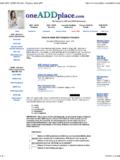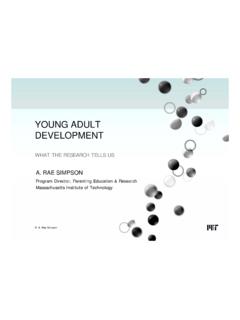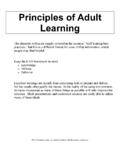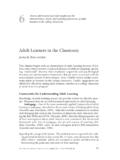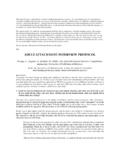Transcription of Adult ADHD Self-Report Scale (ASRS-v1.1) …
1 Adult adhd Self-Report Scale ( ) Symptom Checklist InstructionsThis checklist can be downloaded at Adult ADD Coach Pete Quily's 100 page + ADD Resource Website questions on the back page are designed to stimulate dialogue between you and your patients and tohelp confirm if they may be suffering from the symptoms of attention-deficit/hyperactivity disorder ( adhd ).Description: The Symptom Checklist is an instrument consisting of the 18 DSM-IV-TR criteria. Sixof the eighteen questions were found to be the most predictive of symptoms consistent withADHD. These six questions are the basis for the ASRS Screener and are also Part A of theSymptom Checklist. Part B of the Symptom Checklist contains the remaining 12 :Symptoms1. Ask the patient to complete both Part A and Part B of the Symptom Checklist by markingan X in the box that most closely represents the frequency of occurrence of each of Score Part A. If four or more marks appear in the darkly shaded boxes within Part A thenthe patient has symptoms highly consistent with adhd in adults and furtherinvestigation is The frequency scores on Part B provide additional cues and can serve as further probesinto the patient s symptoms.
2 Pay particular attention to marks appearing in the darkshaded boxes. The frequency-based response is more sensitive with certain total score or diagnostic likelihood is utilized for the twelve questions. It has beenfound that the six questions in Part A are the most predictive of the disorder and arebest for use as a screening Review the entire Symptom Checklist with your patients and evaluate the level ofimpairment associated with the Consider work/school, social and family Symptom frequency is often associated with symptom severity, therefore the SymptomChecklist may also aid in the assessment of impairments. If your patients have frequentsymptoms, you may want to ask them to describe how these problems have affected theability to work, take care of things at home, or get along with other people such as theirspouse/significant Assess the presence of these symptoms or similar symptoms in childhood. adults whohave adhd need not have been formally diagnosed in childhood.
3 In evaluating apatient s history, look for evidence of early-appearing and long-standing problems withattention or self -control. Some significant symptoms should have been present inchildhood, but full symptomology is not OftenAdult adhd Self-Report Scale ( ) Symptom ChecklistPlease answer the questions below, rating yourself on each of the criteria shown using thescale on the right side of the page. As you answer each question, place an X in the box thatbest describes how you have felt and conducted yourself over the past 6 months. Please givethis completed checklist to your healthcare professional to discuss during today NameToday s often do you have trouble wrapping up the final details of a project, once the challenging parts have been done?2. How often do you have difficulty getting things in order when you have to do a task that requires organization?3. How often do you have problems remembering appointments or obligations?4. often do you fidget or squirm with your hands or feet when you have to sit down for a long time?
4 Often do you feel overly active and compelled to do things, like you were driven by a motor? often do you make careless mistakes when you have to work on a boring ordifficult project? often do you have difficulty keeping your attention when you are doing boringor repetitive work? often do you have difficulty concentrating on what people say to you, even when they are speaking to you directly? often do you misplace or have difficulty finding things at home or at work? often are you distracted by activity or noise around you? often do you leave your seat in meetings or other situations in which you are expected to remain seated? often do you feel restless or fidgety? often do you have difficulty unwinding and relaxing when you have time to yourself? often do you find yourself talking too much when you are in social situations? you re in a conversation, how often do you find yourself finishing the sentences of the people you are talking to, before they can finish them themselves?
5 Often do you have difficulty waiting your turn in situations when turn taking is required? often do you interrupt others when they are busy?PartB PartA When you have a task that requires a lot of thought, how often do you avoid or delay getting started?The Value of Screening for adults With ADHDR esearch suggests that the symptoms of adhd can persist into adulthood, having a significantimpact on the relationships, careers, and even the personal safety of your patients who maysuffer from Because this disorder is often misunderstood, many people who have it do notreceive appropriate treatment and, as a result, may never reach their full potential. Part of theproblem is that it can be difficult to diagnose, particularly in Adult adhd Self-Report Scale ( ) Symptom Checklist was developedin conjunction with the World Health Organization (WHO), and the Workgroup on AdultADHD that included the following team of psychiatrists and researchers: Lenard Adler, MDAssociate Professor of Psychiatry and NeurologyNew York University Medical School Ronald C.
6 Kessler, PhDProfessor, Department of Health Care PolicyHarvard Medical School Thomas Spencer, MDAssociate Professor of PsychiatryHarvard Medical SchoolAs a healthcare professional, you can use the ASRS as a tool to help screen for adhd inadult patients. Insights gained through this screening may suggest the need for a more in-depthclinician interview. The questions in the ASRS are consistent with DSM-IV criteria andaddress the manifestations of adhd symptoms in adults . Content of the questionnaire alsoreflects the importance that DSM-IV places on symptoms, impairments, and history for a checklist takes about 5 minutes to complete and can provide information that is criticalto supplement the diagnostic :1. Schweitzer JB, et al. Med Clin North Am. 2001;85(3):10-11, Barkley RA. Attention Deficit Hyperactivity Disorder: A Handbook for Diagnosis and Treatment. 2nd ed. Biederman J, et al. Am J ;150 American Psychiatric Association: Diagnostic and Statistical Manual of Mental Disorders, Fourth Edition, , DC, American Psychiatric Association.
7 2000: 85-93.



